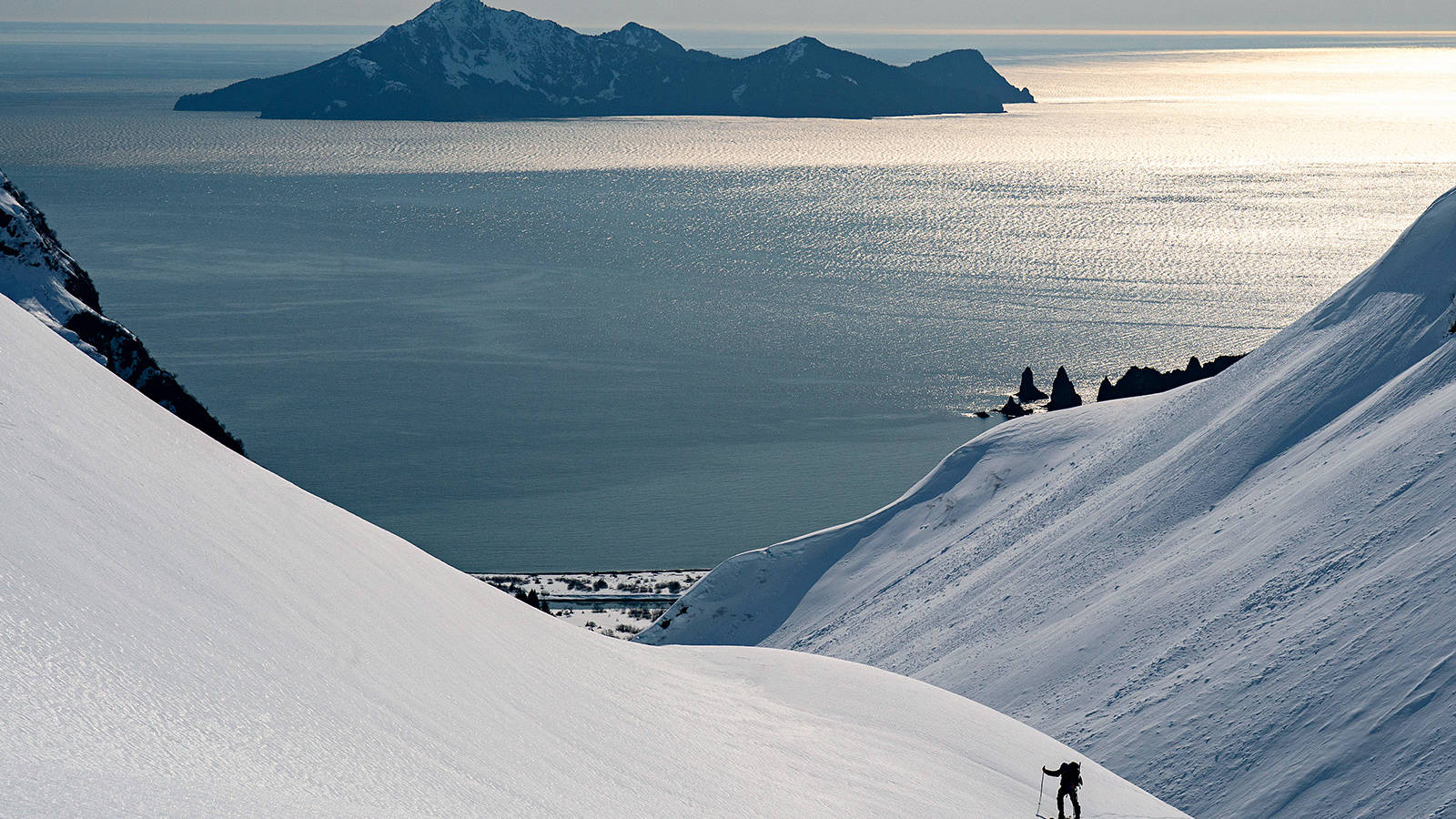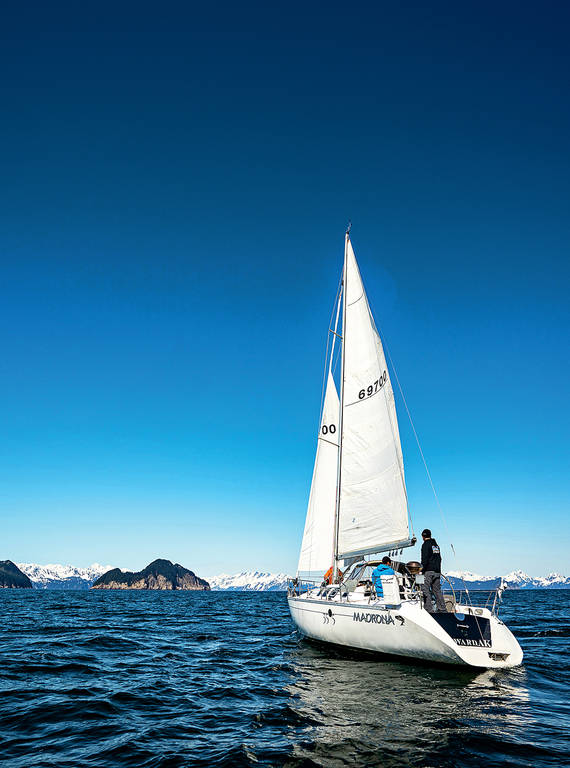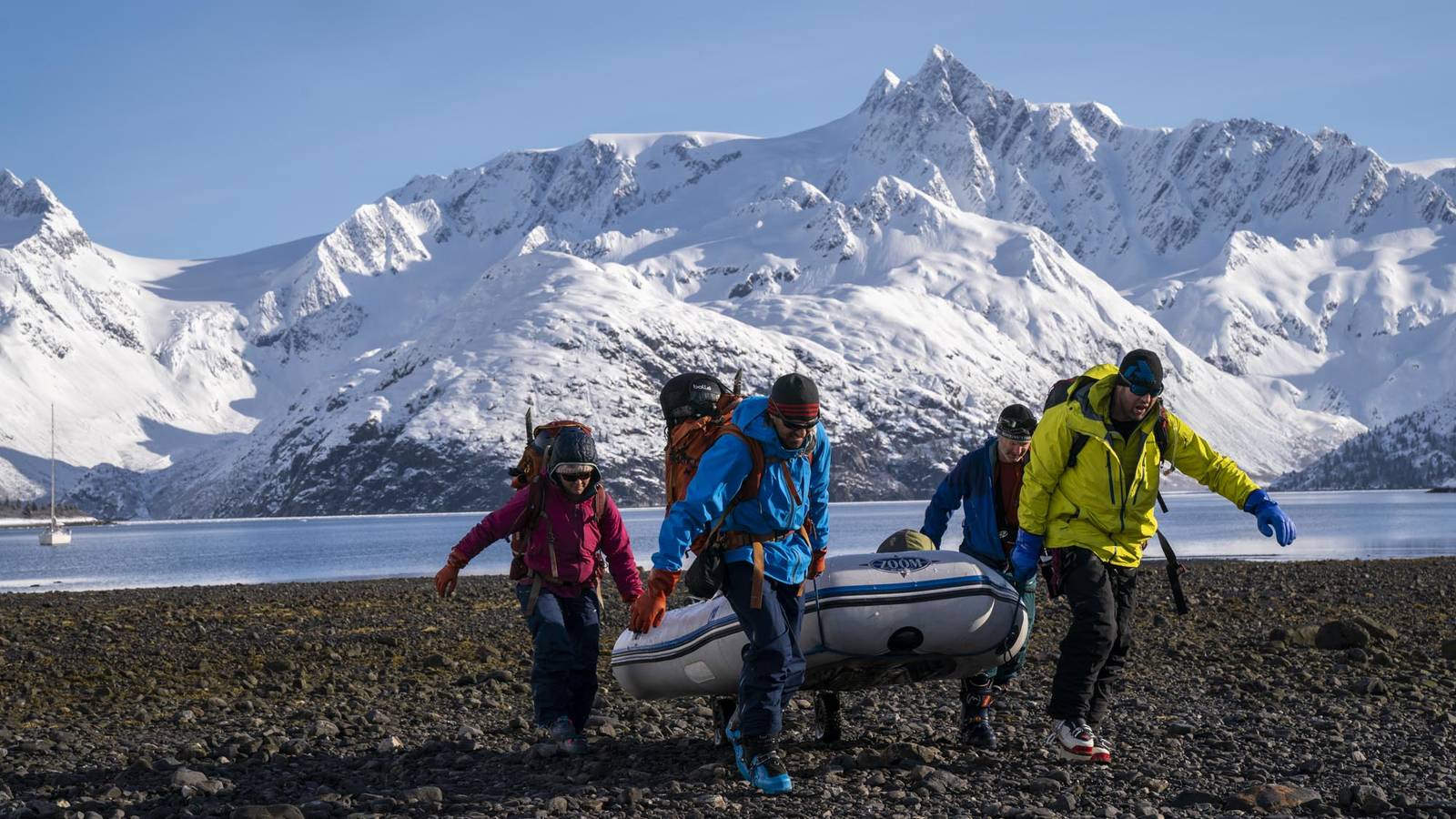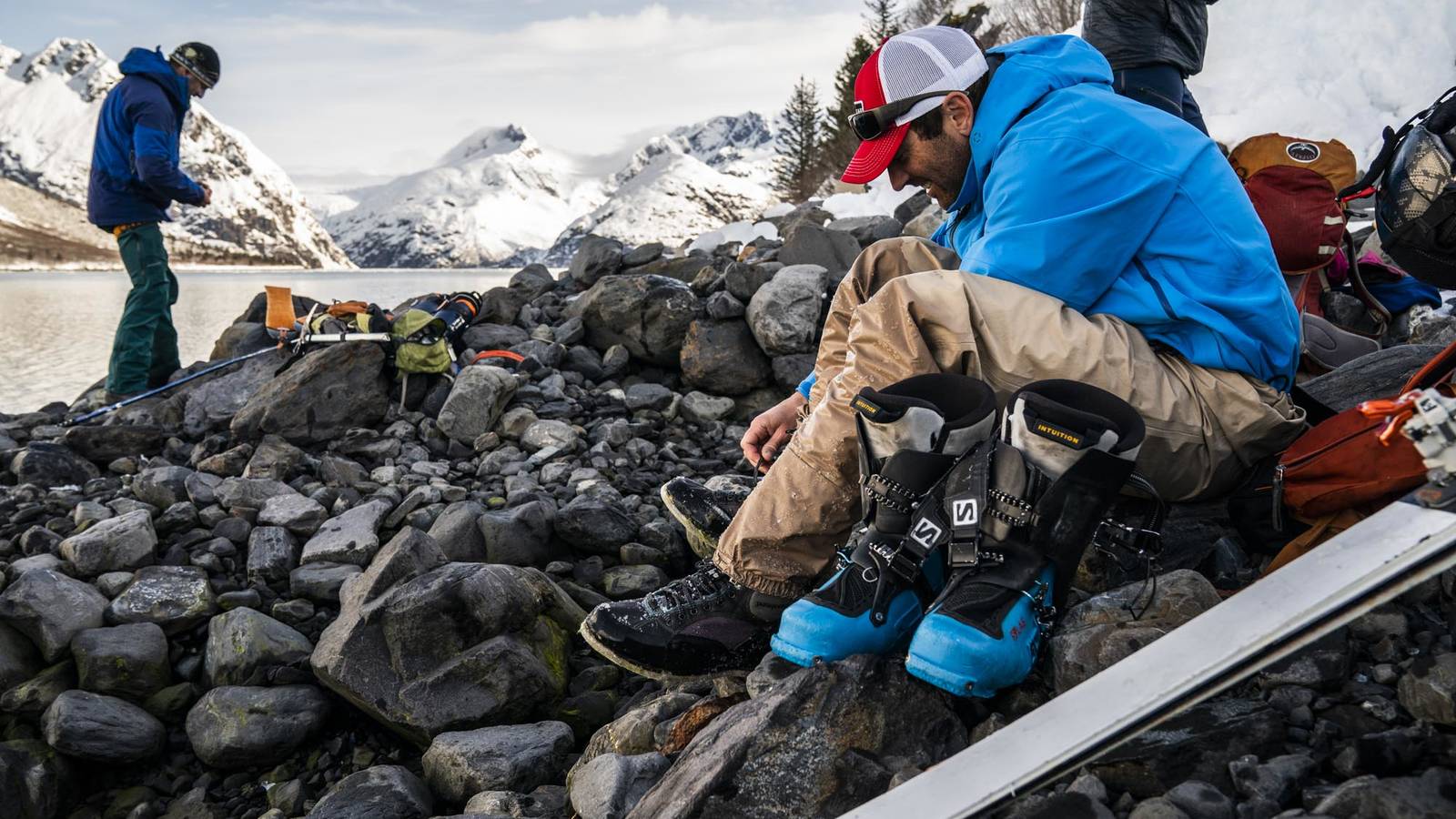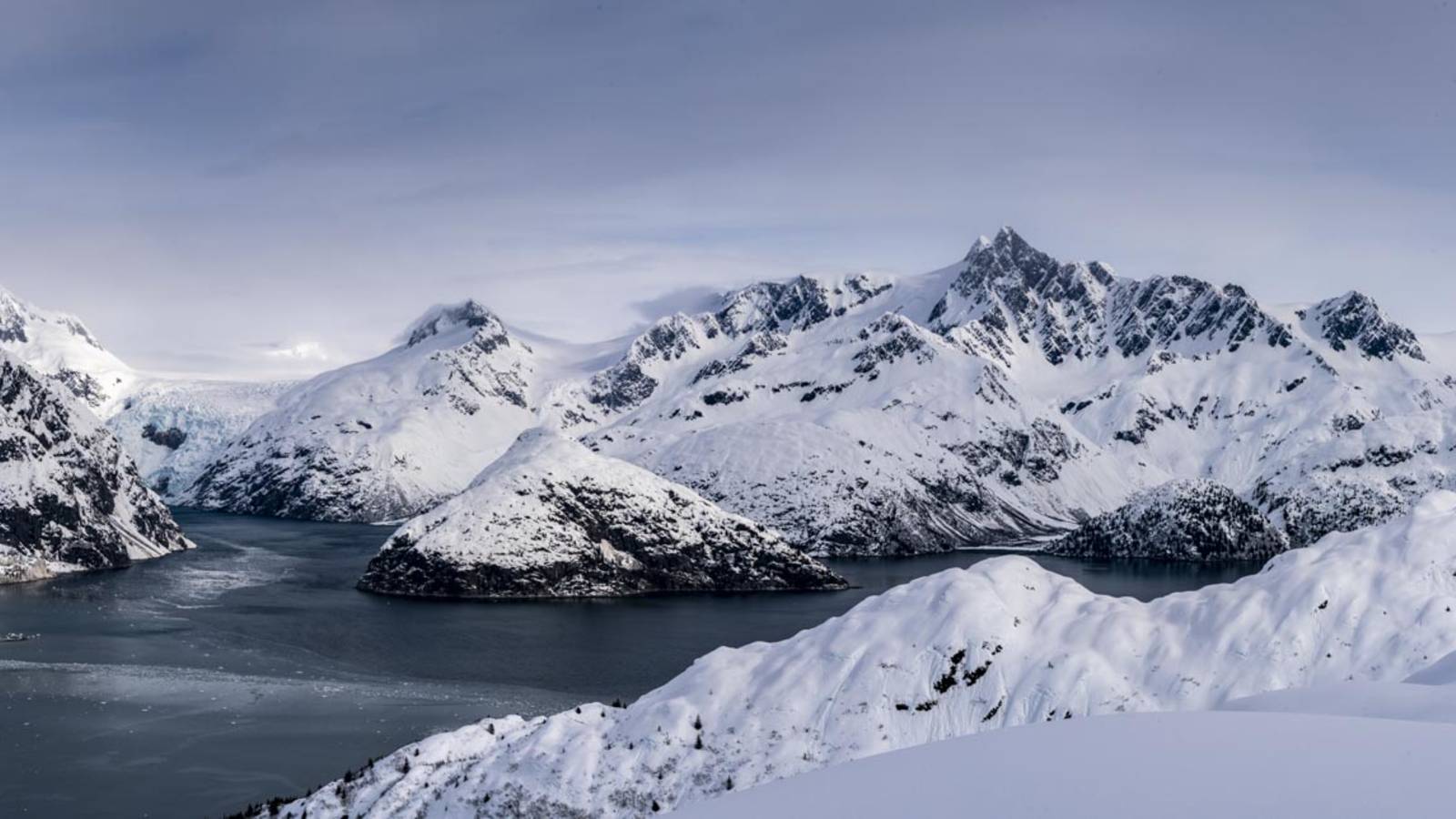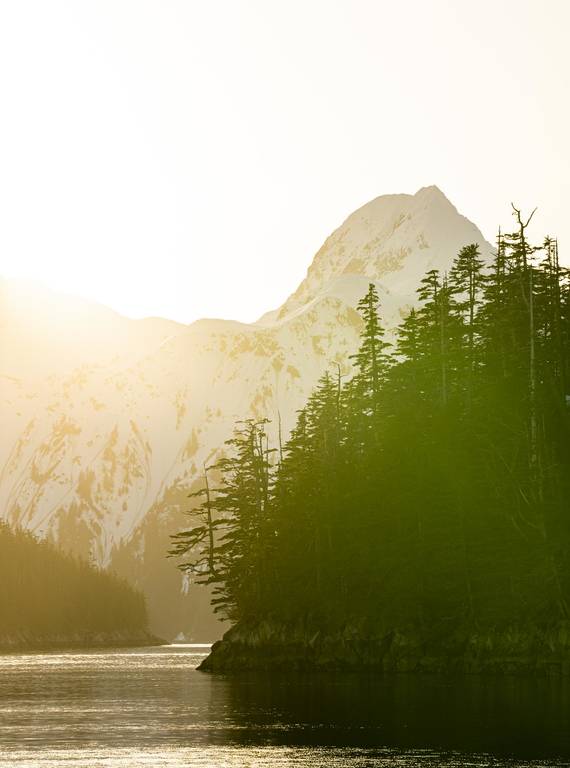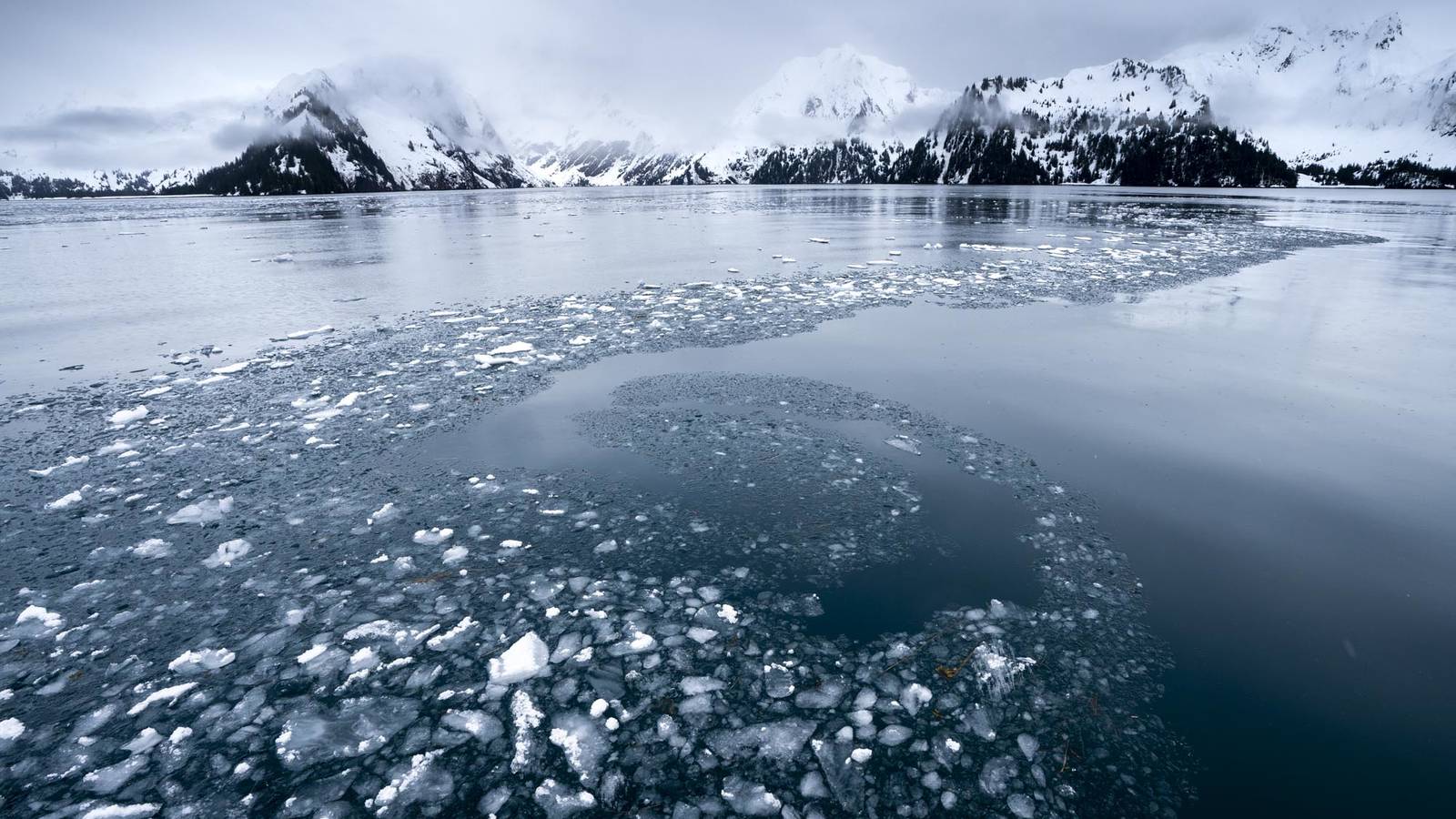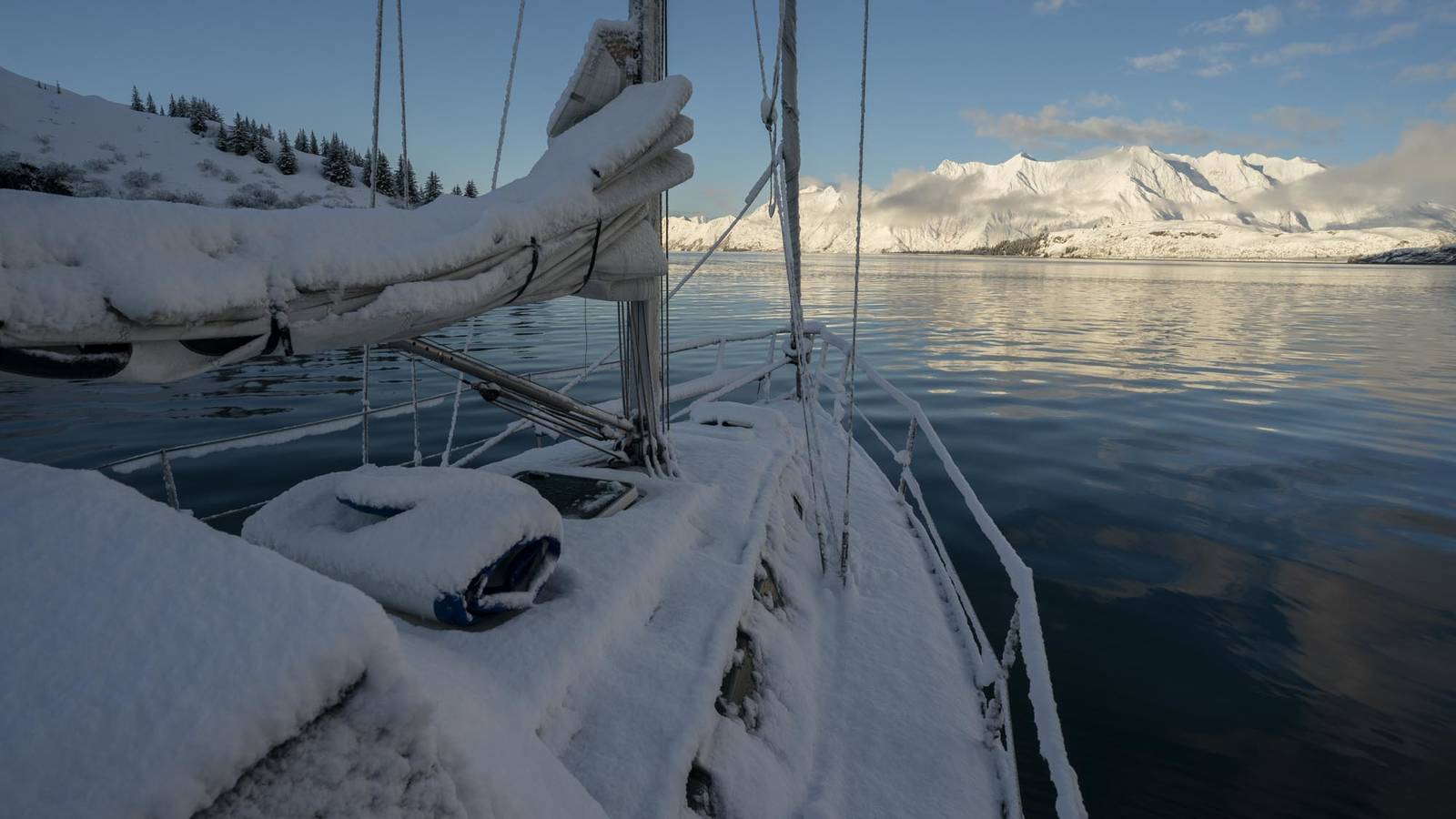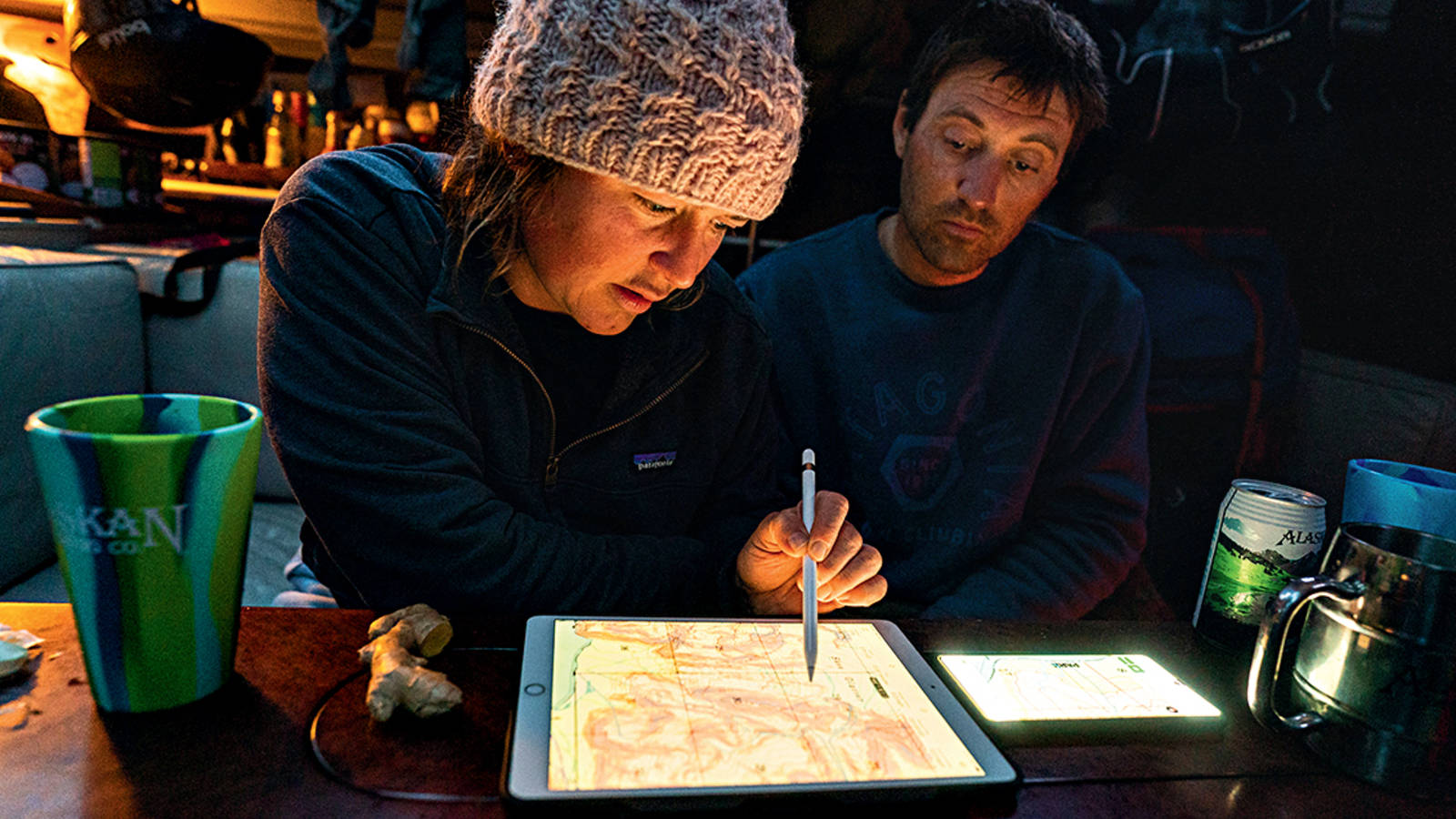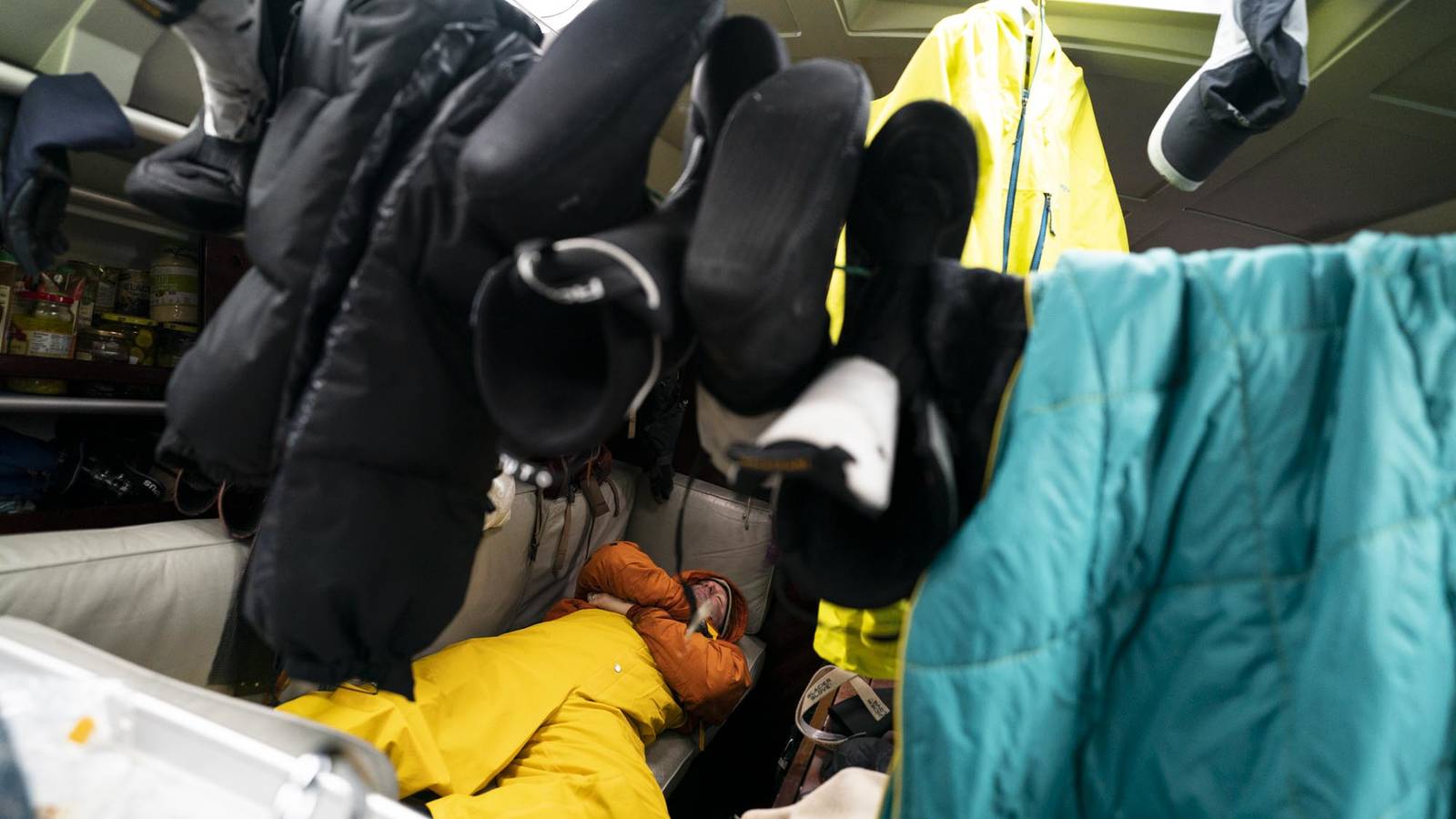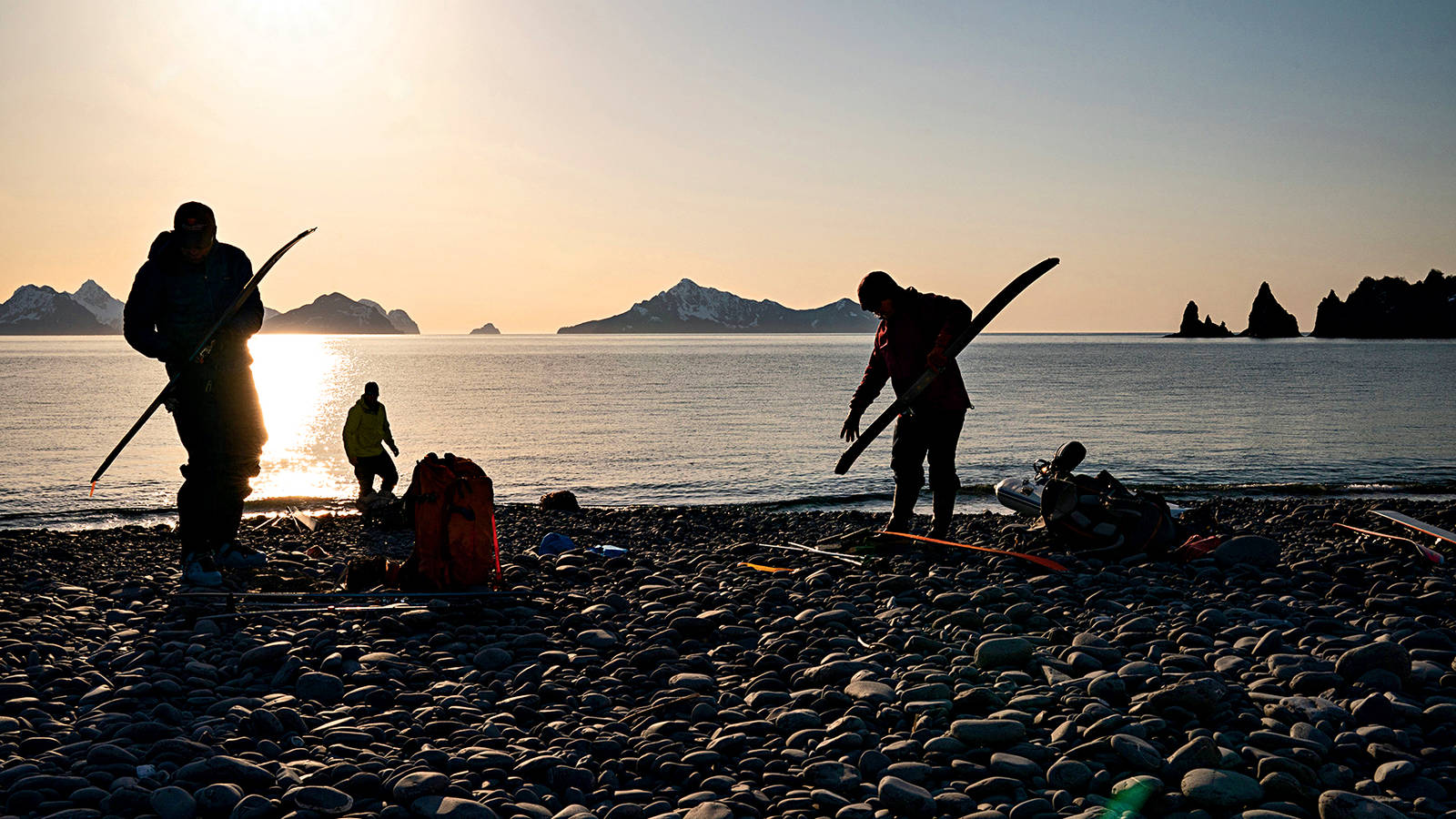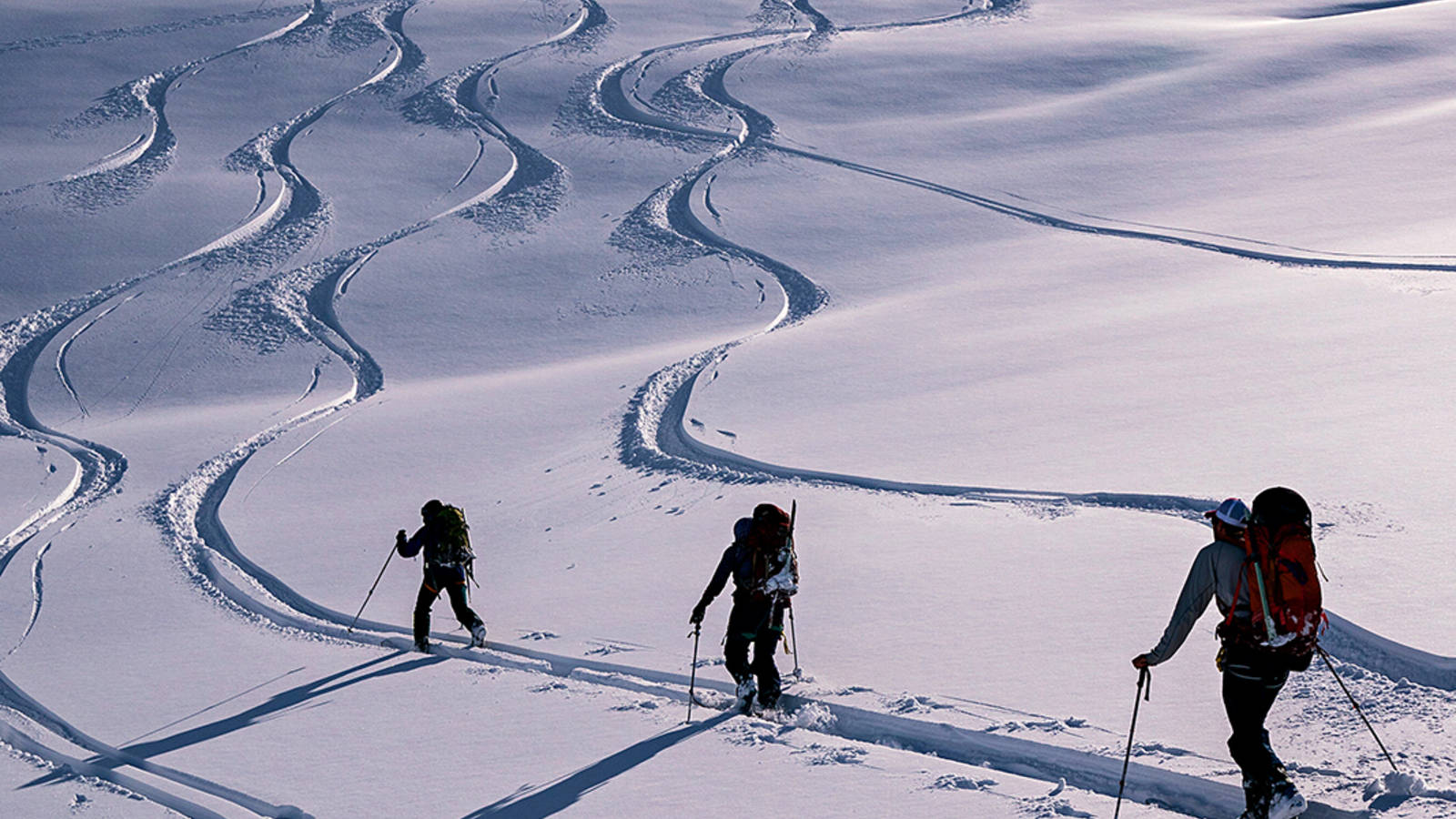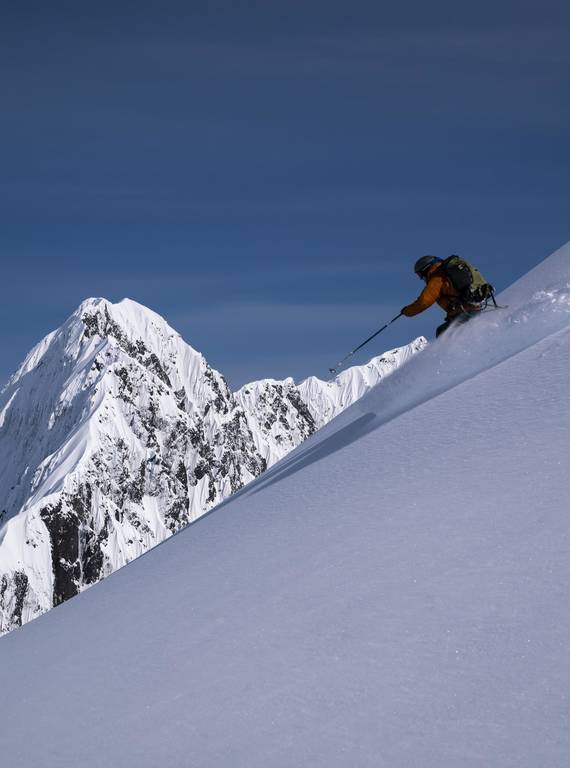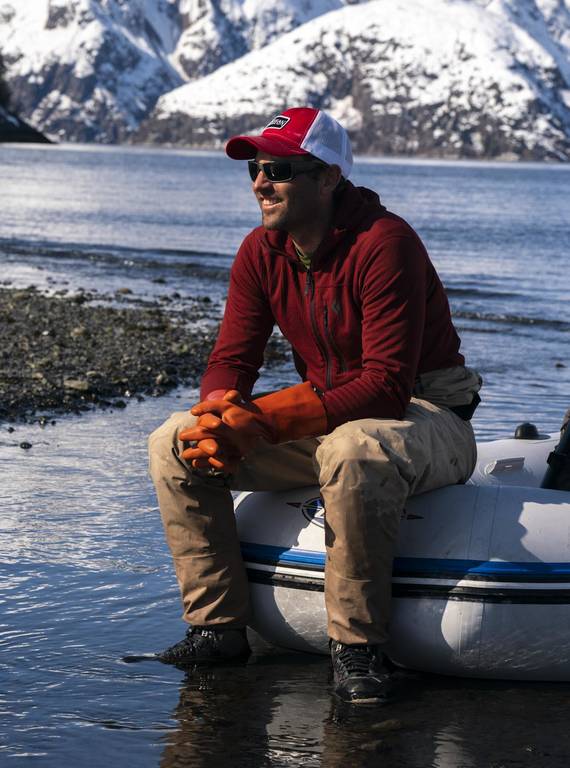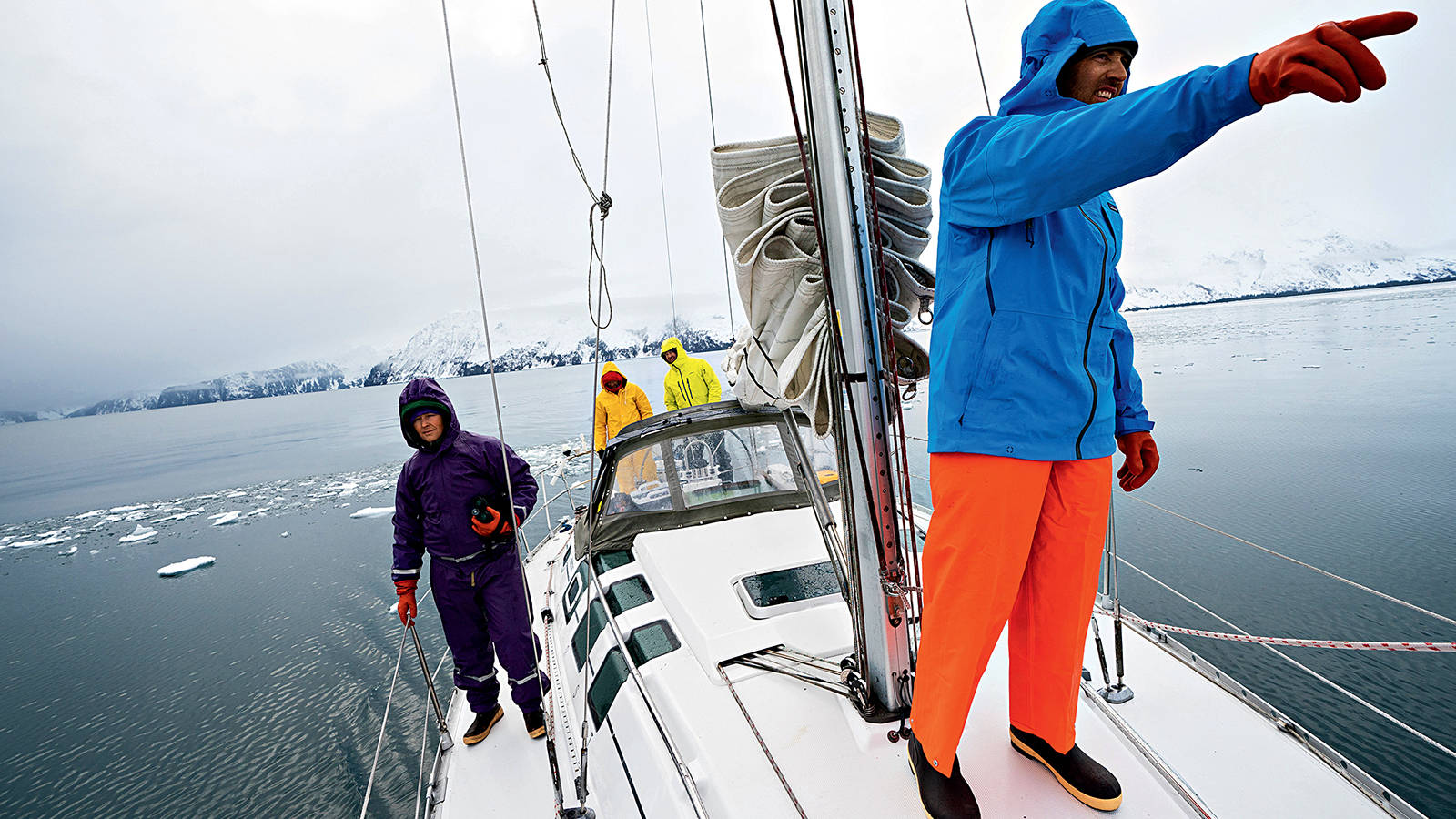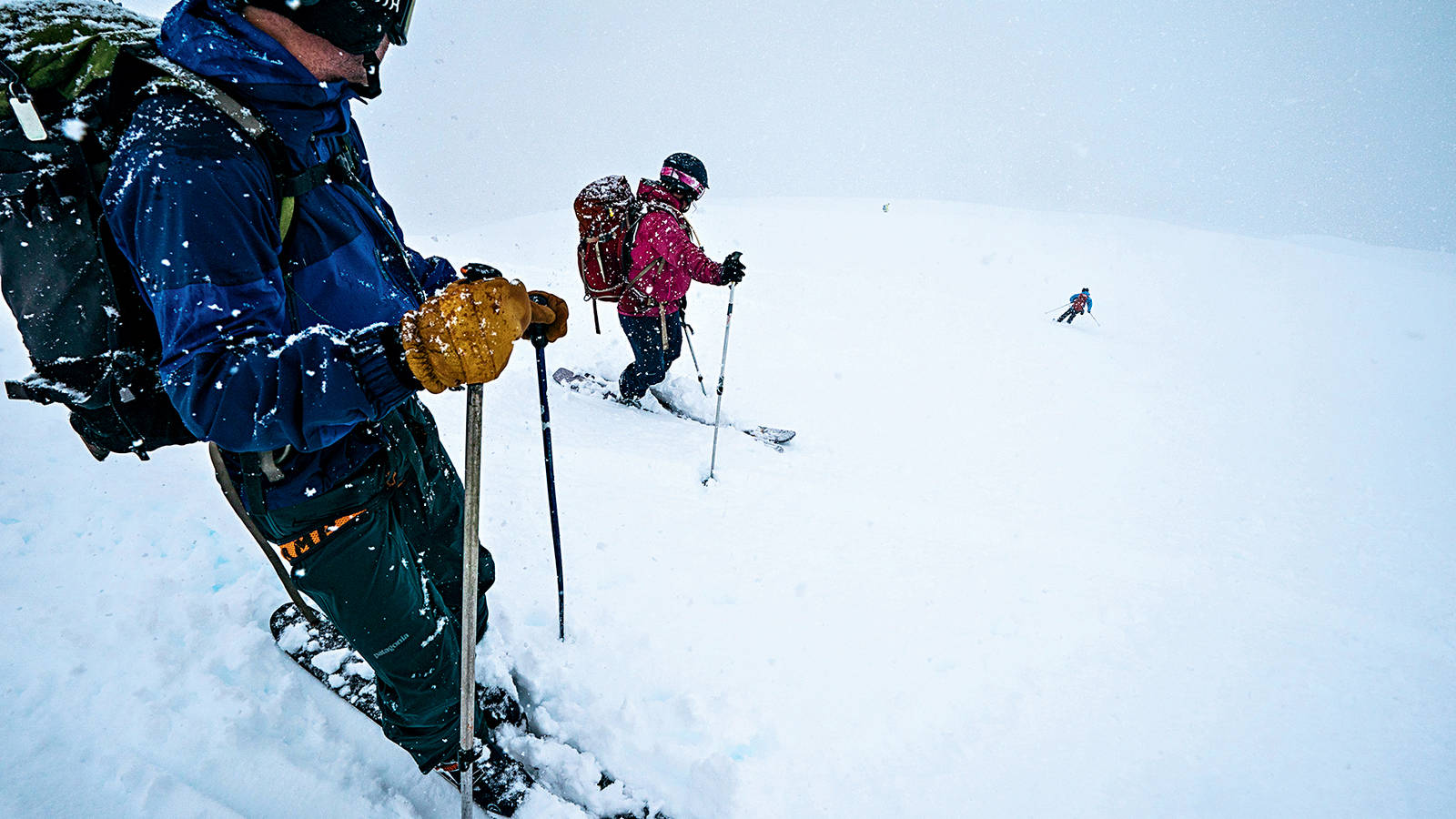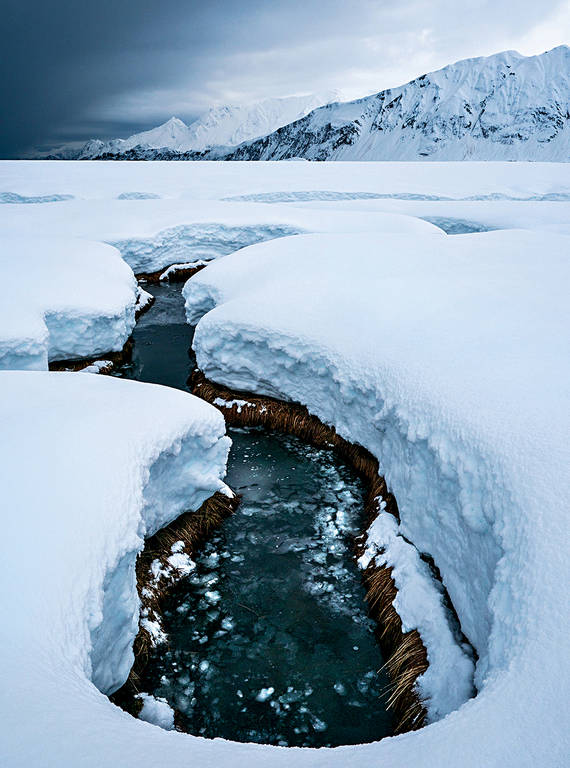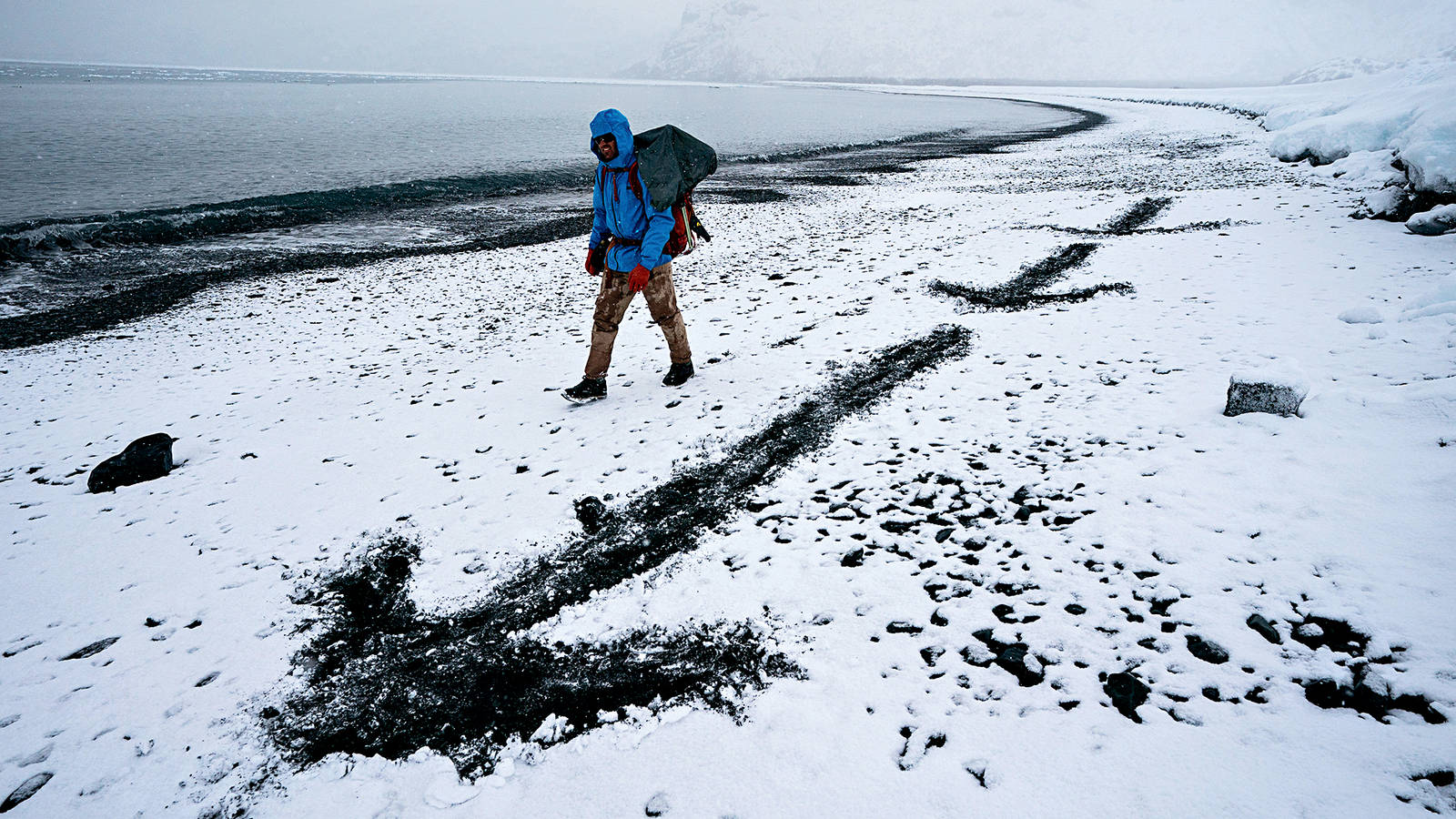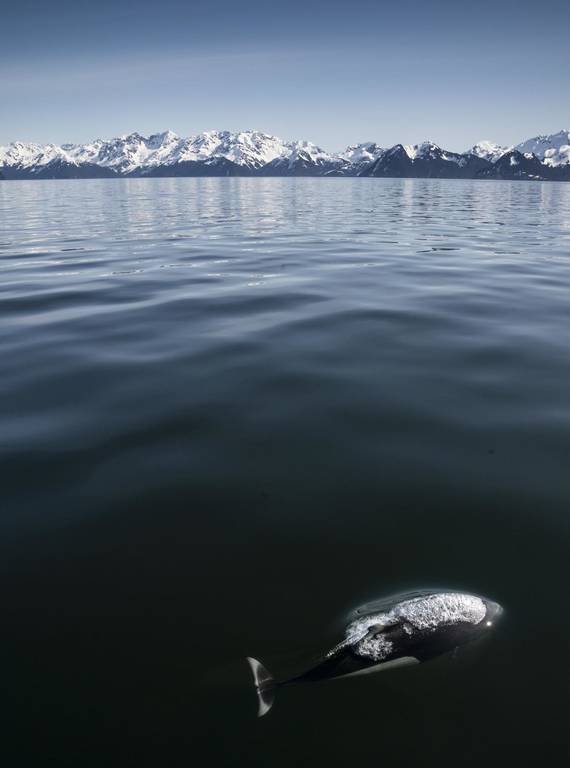Winter 2023
From Peak to Sea
By Craig WolfromA group of backcountry skiers realized their dream of taking on the remote mountains of Alaska’s Kenai Fjords National Park. Photographer Craig Wolfrom documented 10 wild days.
After four days of inclement weather, sailing through swells as high as 8 feet, navigating a dinghy around motor-stalling sea ice, and skiing through whiteout snow squalls and three avalanches, we awoke to bluebird skies. The glassy Pacific Ocean reflected jagged mountains glowing in the early morning’s light. Our floating campsite, a 35-foot Beneteau sailboat, gently bobbed in Northwestern Fjord, which is carved into the southern shore of Alaska’s Kenai Fjords National Park. That brilliant morning, our dream of skiing in stellar conditions from mountain peaks down to the sea was looking like it would become a reality.
The blue line shows the group’s route from Seward to Harris Bay and back. ©KAREN MINOT
Our small group rallied to get the backcountry ski gear — avalanche transceivers, shovels, extra clothing, first-aid kit, food and water — loaded into the dinghy quickly, knowing all too well that the weather could change for the worse any minute. Once on shore, we adhered our climbing skins to the bottom of our skis, shouldered our backpacks and zigzagged our way up a glacier through boot-deep powder that became lighter and softer the higher we climbed. The sun steadily shone through an azure sky. On south-facing aspects, avalanches slid toward the valley floors with unsettling frequency, but on the northern slopes, where we were, an intense stillness held.
The natural beauty and quiet of backcountry skiing make it an exhilarating, nearly sacred experience for devotees. Alaska is a holy land where thousands of thrill-seekers undertake annual expeditions to ranges such as the Chugach or Talkeetna mountains. Our foursome of Idaho and Montana skiers were bent on an adventure that would take us even farther off the grid. We found a willing boat captain — who is a ski enthusiast to boot — and after months of careful planning, we set sail in early April from the small Alaska town of Seward to spend 10 days exploring and skiing in Kenai Fjords. The 670,000-acre park boasts dozens of glaciers and scores of peaks, most of which are unnamed; the highest reaches 6,450 feet. Just a fraction of the park’s visitors — 412,000 in 2021, most of whom traveled there in the summer — hire bush planes or venture off the park’s only road or disembark from their sightseeing boats to ski and hike. So for those like us seeking a remote backcountry adventure, the park is an unparalleled playground.
During their time in the park, the only human presence the group encountered was a single helicopter that flew overhead. Here, Goodell climbs an unnamed peak above Bulldog Cove.
©CRAIG WOLFROMErin Griffith pulls a cart along the docks of Seward Boat Harbor. The friends’ gear will be stowed in their chartered sailboat, Madrona. Because most of Kenai Fjords National Park is roadless, those visitors not restricting themselves to Exit Glacier (the only spot accessed by car) must arrive by boat or plane.
©CRAIG WOLFROMThe Madrona on a still and sunny day. Using Wolfrom’s drone to snap aerial pictures while at sea was “difficult at best,” he said. On the machine’s inaugural outing, Wolfrom accidentally flew the drone into one of the mast’s guy lines as the boat was pulling out of Seward. In the captain’s attempt to save the spiraling drone, he cut his palm, prompting an emergency room visit and five stitches.
©CRAIG WOLFROMOn a rare blue-sky day, the group sails in waters off Kenai Fjords National Park. Wolfrom took this photo from the dinghy rather than using his drone, in part because of the machine’s disastrous first outing.
©CRAIG WOLFROMThe group hauls the dinghy through the tidal zone, stashing it high enough to prevent it from being swept back to sea while they ski. Navigating between the sailboat, the dinghy and the shore was a continual challenge. “Getting wet was not an option,” Wolfrom said, as hypothermia this far from the nearest town could be life-threatening.
©CRAIG WOLFROMBaldwin Goodell, Jacob Chaney and Erin Griffith gear up for the day along the edge of Harris Bay.
©CRAIG WOLFROMView of the retreating Northwestern Glacier (just visible on the left). A topographic map from the 1950s that the friends used indicated the Madrona was anchored where the glacier once stood.
©CRAIG WOLFROMPartners Erin Griffith and Jacob Chaney (in blue), who are both registered paramedics and wildland firefighters, ascend a slope by Aialik Bay.
©CRAIG WOLFROMGriffith drops into the fresh powder above Harris Bay.
©CRAIG WOLFROMRipple Cove at sunset with the ridgeline of Granite Island in the distance.
©CRAIG WOLFROMSwirling ice on Aialik Bay.
©CRAIG WOLFROMWaking to a fresh dusting of snow on the Madrona. Finding the boat in the same place it had been anchored the night before was a constant relief to the five people on board. Swells from the Gulf of Alaska have been known to surge into the fjords, lifting boat anchors off the ocean floor and causing boats to drift.
©CRAIG WOLFROMGriffith and Chaney plot out the next day’s routes in the cozy cabin of the Madrona.
©CRAIG WOLFROMBaldwin Goodell relaxes below deck as various items of apparel hang from makeshift laundry lines. Condensation was a fact of life in the cabin. Wet weather and five people’s breathing combined to make drying clothes nearly impossible.
©CRAIG WOLFROMSunrise finds the team on the shore of Bulldog Cove, preparing for another day of backcountry skiing.
©CRAIG WOLFROMMembers of the group retrace their tracks as they head back up to the peak. Over the course of six days, they climbed over 19,000 feet of elevation on their skis.
©CRAIG WOLFROM
While the friends had mapped out which mountains they planned to ski prior to arriving in Alaska, physically being in the landscape and discovering which slopes were safest and had the best snow ultimately dictated their routes.
©CRAIG WOLFROMThe park isn’t just staggering slopes and frigid waters. Here, members of the team ski through a flat and moss-draped forest behind Bulldog Cove on the Aialik Peninsula.
©CRAIG WOLFROMJacob Chaney enjoys another day in Kenai Fjords.
©CRAIG WOLFROMCaptain Nathan Straubinger (at the helm) steers the 35-foot Madrona through the ice on Aialik Bay as Chaney (pointing), Griffith and Baldwin Goodell serve as lookouts. Though the group had hoped that much of the distance could be covered with sails unfurled, the winds were frequently too light. Boating still turned out to be a low-carbon method of travel, requiring only about 30 gallons of diesel for the 10-day trip.
©CRAIG WOLFROMGoodell and Griffith watch as Chaney skis in near-whiteout conditions above Aialik Bay. Snowstorms, while expected, occasionally changed the group’s well-crafted plans. On one particularly treacherous day, they built a small snow cave on the side of a mountain to wait out a squall.
©CRAIG WOLFROMThe wintry landscape of Kenai Fjords National Park.
©CRAIG WOLFROMOnly three people could fit in the dinghy, so every journey to and from the sailboat required two shuttles of skiers and gear. On this day, the first crew had to cut the motor and paddle because of chunks of ice on the bay. Confused by the delay and unable to contact anyone using their VHF radio, Wolfrom and Chaney (who had been left on shore) drew arrows to show where they had gone. Twenty minutes later, they heard the hum of the dinghy’s motor. Salvation.
©CRAIG WOLFROM
A Dall’s porpoise, named for the American naturalist William Healy Dall, surfaces in Resurrection Bay as the group makes its way to Seward on the last day.
©CRAIG WOLFROMDuring their time in the park, the only human presence the group encountered was a single helicopter that flew overhead. Here, Goodell climbs an unnamed peak above Bulldog Cove.
©CRAIG WOLFROMErin Griffith pulls a cart along the docks of Seward Boat Harbor. The friends’ gear will be stowed in their chartered sailboat, Madrona. Because most of Kenai Fjords National Park is roadless, those visitors not restricting themselves to Exit Glacier (the only spot accessed by car) must arrive by boat or plane.
©CRAIG WOLFROMThe Madrona on a still and sunny day. Using Wolfrom’s drone to snap aerial pictures while at sea was “difficult at best,” he said. On the machine’s inaugural outing, Wolfrom accidentally flew the drone into one of the mast’s guy lines as the boat was pulling out of Seward. In the captain’s attempt to save the spiraling drone, he cut his palm, prompting an emergency room visit and five stitches.
©CRAIG WOLFROMOn a rare blue-sky day, the group sails in waters off Kenai Fjords National Park. Wolfrom took this photo from the dinghy rather than using his drone, in part because of the machine’s disastrous first outing.
©CRAIG WOLFROMThe group hauls the dinghy through the tidal zone, stashing it high enough to prevent it from being swept back to sea while they ski. Navigating between the sailboat, the dinghy and the shore was a continual challenge. “Getting wet was not an option,” Wolfrom said, as hypothermia this far from the nearest town could be life-threatening.
©CRAIG WOLFROMBaldwin Goodell, Jacob Chaney and Erin Griffith gear up for the day along the edge of Harris Bay.
©CRAIG WOLFROMView of the retreating Northwestern Glacier (just visible on the left). A topographic map from the 1950s that the friends used indicated the Madrona was anchored where the glacier once stood.
©CRAIG WOLFROMPartners Erin Griffith and Jacob Chaney (in blue), who are both registered paramedics and wildland firefighters, ascend a slope by Aialik Bay.
©CRAIG WOLFROMGriffith drops into the fresh powder above Harris Bay.
©CRAIG WOLFROMRipple Cove at sunset with the ridgeline of Granite Island in the distance.
©CRAIG WOLFROMSwirling ice on Aialik Bay.
©CRAIG WOLFROMWaking to a fresh dusting of snow on the Madrona. Finding the boat in the same place it had been anchored the night before was a constant relief to the five people on board. Swells from the Gulf of Alaska have been known to surge into the fjords, lifting boat anchors off the ocean floor and causing boats to drift.
©CRAIG WOLFROMGriffith and Chaney plot out the next day’s routes in the cozy cabin of the Madrona.
©CRAIG WOLFROMBaldwin Goodell relaxes below deck as various items of apparel hang from makeshift laundry lines. Condensation was a fact of life in the cabin. Wet weather and five people’s breathing combined to make drying clothes nearly impossible.
©CRAIG WOLFROMSunrise finds the team on the shore of Bulldog Cove, preparing for another day of backcountry skiing.
©CRAIG WOLFROMMembers of the group retrace their tracks as they head back up to the peak. Over the course of six days, they climbed over 19,000 feet of elevation on their skis.
©CRAIG WOLFROM
While the friends had mapped out which mountains they planned to ski prior to arriving in Alaska, physically being in the landscape and discovering which slopes were safest and had the best snow ultimately dictated their routes.
©CRAIG WOLFROMThe park isn’t just staggering slopes and frigid waters. Here, members of the team ski through a flat and moss-draped forest behind Bulldog Cove on the Aialik Peninsula.
©CRAIG WOLFROMJacob Chaney enjoys another day in Kenai Fjords.
©CRAIG WOLFROMCaptain Nathan Straubinger (at the helm) steers the 35-foot Madrona through the ice on Aialik Bay as Chaney (pointing), Griffith and Baldwin Goodell serve as lookouts. Though the group had hoped that much of the distance could be covered with sails unfurled, the winds were frequently too light. Boating still turned out to be a low-carbon method of travel, requiring only about 30 gallons of diesel for the 10-day trip.
©CRAIG WOLFROMGoodell and Griffith watch as Chaney skis in near-whiteout conditions above Aialik Bay. Snowstorms, while expected, occasionally changed the group’s well-crafted plans. On one particularly treacherous day, they built a small snow cave on the side of a mountain to wait out a squall.
©CRAIG WOLFROMThe wintry landscape of Kenai Fjords National Park.
©CRAIG WOLFROMOnly three people could fit in the dinghy, so every journey to and from the sailboat required two shuttles of skiers and gear. On this day, the first crew had to cut the motor and paddle because of chunks of ice on the bay. Confused by the delay and unable to contact anyone using their VHF radio, Wolfrom and Chaney (who had been left on shore) drew arrows to show where they had gone. Twenty minutes later, they heard the hum of the dinghy’s motor. Salvation.
©CRAIG WOLFROM
A Dall’s porpoise, named for the American naturalist William Healy Dall, surfaces in Resurrection Bay as the group makes its way to Seward on the last day.
©CRAIG WOLFROMDuring their time in the park, the only human presence the group encountered was a single helicopter that flew overhead. Here, Goodell climbs an unnamed peak above Bulldog Cove.
©CRAIG WOLFROMDuring their time in the park, the only human presence the group encountered was a single helicopter that flew overhead. Here, Goodell climbs an unnamed peak above Bulldog Cove.
©CRAIG WOLFROMErin Griffith pulls a cart along the docks of Seward Boat Harbor. The friends’ gear will be stowed in their chartered sailboat, Madrona. Because most of Kenai Fjords National Park is roadless, those visitors not restricting themselves to Exit Glacier (the only spot accessed by car) must arrive by boat or plane.
©CRAIG WOLFROMThe Madrona on a still and sunny day. Using Wolfrom’s drone to snap aerial pictures while at sea was “difficult at best,” he said. On the machine’s inaugural outing, Wolfrom accidentally flew the drone into one of the mast’s guy lines as the boat was pulling out of Seward. In the captain’s attempt to save the spiraling drone, he cut his palm, prompting an emergency room visit and five stitches.
©CRAIG WOLFROMOn a rare blue-sky day, the group sails in waters off Kenai Fjords National Park. Wolfrom took this photo from the dinghy rather than using his drone, in part because of the machine’s disastrous first outing.
©CRAIG WOLFROMThe group hauls the dinghy through the tidal zone, stashing it high enough to prevent it from being swept back to sea while they ski. Navigating between the sailboat, the dinghy and the shore was a continual challenge. “Getting wet was not an option,” Wolfrom said, as hypothermia this far from the nearest town could be life-threatening.
©CRAIG WOLFROMBaldwin Goodell, Jacob Chaney and Erin Griffith gear up for the day along the edge of Harris Bay.
©CRAIG WOLFROMView of the retreating Northwestern Glacier (just visible on the left). A topographic map from the 1950s that the friends used indicated the Madrona was anchored where the glacier once stood.
©CRAIG WOLFROMPartners Erin Griffith and Jacob Chaney (in blue), who are both registered paramedics and wildland firefighters, ascend a slope by Aialik Bay.
©CRAIG WOLFROMGriffith drops into the fresh powder above Harris Bay.
©CRAIG WOLFROMRipple Cove at sunset with the ridgeline of Granite Island in the distance.
©CRAIG WOLFROMSwirling ice on Aialik Bay.
©CRAIG WOLFROMWaking to a fresh dusting of snow on the Madrona. Finding the boat in the same place it had been anchored the night before was a constant relief to the five people on board. Swells from the Gulf of Alaska have been known to surge into the fjords, lifting boat anchors off the ocean floor and causing boats to drift.
©CRAIG WOLFROMGriffith and Chaney plot out the next day’s routes in the cozy cabin of the Madrona.
©CRAIG WOLFROMBaldwin Goodell relaxes below deck as various items of apparel hang from makeshift laundry lines. Condensation was a fact of life in the cabin. Wet weather and five people’s breathing combined to make drying clothes nearly impossible.
©CRAIG WOLFROMSunrise finds the team on the shore of Bulldog Cove, preparing for another day of backcountry skiing.
©CRAIG WOLFROMMembers of the group retrace their tracks as they head back up to the peak. Over the course of six days, they climbed over 19,000 feet of elevation on their skis.
©CRAIG WOLFROM
While the friends had mapped out which mountains they planned to ski prior to arriving in Alaska, physically being in the landscape and discovering which slopes were safest and had the best snow ultimately dictated their routes.
©CRAIG WOLFROMThe park isn’t just staggering slopes and frigid waters. Here, members of the team ski through a flat and moss-draped forest behind Bulldog Cove on the Aialik Peninsula.
©CRAIG WOLFROMJacob Chaney enjoys another day in Kenai Fjords.
©CRAIG WOLFROMCaptain Nathan Straubinger (at the helm) steers the 35-foot Madrona through the ice on Aialik Bay as Chaney (pointing), Griffith and Baldwin Goodell serve as lookouts. Though the group had hoped that much of the distance could be covered with sails unfurled, the winds were frequently too light. Boating still turned out to be a low-carbon method of travel, requiring only about 30 gallons of diesel for the 10-day trip.
©CRAIG WOLFROMGoodell and Griffith watch as Chaney skis in near-whiteout conditions above Aialik Bay. Snowstorms, while expected, occasionally changed the group’s well-crafted plans. On one particularly treacherous day, they built a small snow cave on the side of a mountain to wait out a squall.
©CRAIG WOLFROMThe wintry landscape of Kenai Fjords National Park.
©CRAIG WOLFROMOnly three people could fit in the dinghy, so every journey to and from the sailboat required two shuttles of skiers and gear. On this day, the first crew had to cut the motor and paddle because of chunks of ice on the bay. Confused by the delay and unable to contact anyone using their VHF radio, Wolfrom and Chaney (who had been left on shore) drew arrows to show where they had gone. Twenty minutes later, they heard the hum of the dinghy’s motor. Salvation.
©CRAIG WOLFROM
A Dall’s porpoise, named for the American naturalist William Healy Dall, surfaces in Resurrection Bay as the group makes its way to Seward on the last day.
©CRAIG WOLFROMDuring their time in the park, the only human presence the group encountered was a single helicopter that flew overhead. Here, Goodell climbs an unnamed peak above Bulldog Cove.
©CRAIG WOLFROMErin Griffith pulls a cart along the docks of Seward Boat Harbor. The friends’ gear will be stowed in their chartered sailboat, Madrona. Because most of Kenai Fjords National Park is roadless, those visitors not restricting themselves to Exit Glacier (the only spot accessed by car) must arrive by boat or plane.
©CRAIG WOLFROMThe Madrona on a still and sunny day. Using Wolfrom’s drone to snap aerial pictures while at sea was “difficult at best,” he said. On the machine’s inaugural outing, Wolfrom accidentally flew the drone into one of the mast’s guy lines as the boat was pulling out of Seward. In the captain’s attempt to save the spiraling drone, he cut his palm, prompting an emergency room visit and five stitches.
©CRAIG WOLFROMOn a rare blue-sky day, the group sails in waters off Kenai Fjords National Park. Wolfrom took this photo from the dinghy rather than using his drone, in part because of the machine’s disastrous first outing.
©CRAIG WOLFROMThe group hauls the dinghy through the tidal zone, stashing it high enough to prevent it from being swept back to sea while they ski. Navigating between the sailboat, the dinghy and the shore was a continual challenge. “Getting wet was not an option,” Wolfrom said, as hypothermia this far from the nearest town could be life-threatening.
©CRAIG WOLFROMBaldwin Goodell, Jacob Chaney and Erin Griffith gear up for the day along the edge of Harris Bay.
©CRAIG WOLFROMView of the retreating Northwestern Glacier (just visible on the left). A topographic map from the 1950s that the friends used indicated the Madrona was anchored where the glacier once stood.
©CRAIG WOLFROMPartners Erin Griffith and Jacob Chaney (in blue), who are both registered paramedics and wildland firefighters, ascend a slope by Aialik Bay.
©CRAIG WOLFROMGriffith drops into the fresh powder above Harris Bay.
©CRAIG WOLFROMRipple Cove at sunset with the ridgeline of Granite Island in the distance.
©CRAIG WOLFROMSwirling ice on Aialik Bay.
©CRAIG WOLFROMWaking to a fresh dusting of snow on the Madrona. Finding the boat in the same place it had been anchored the night before was a constant relief to the five people on board. Swells from the Gulf of Alaska have been known to surge into the fjords, lifting boat anchors off the ocean floor and causing boats to drift.
©CRAIG WOLFROMGriffith and Chaney plot out the next day’s routes in the cozy cabin of the Madrona.
©CRAIG WOLFROMBaldwin Goodell relaxes below deck as various items of apparel hang from makeshift laundry lines. Condensation was a fact of life in the cabin. Wet weather and five people’s breathing combined to make drying clothes nearly impossible.
©CRAIG WOLFROMSunrise finds the team on the shore of Bulldog Cove, preparing for another day of backcountry skiing.
©CRAIG WOLFROMMembers of the group retrace their tracks as they head back up to the peak. Over the course of six days, they climbed over 19,000 feet of elevation on their skis.
©CRAIG WOLFROM
While the friends had mapped out which mountains they planned to ski prior to arriving in Alaska, physically being in the landscape and discovering which slopes were safest and had the best snow ultimately dictated their routes.
©CRAIG WOLFROMThe park isn’t just staggering slopes and frigid waters. Here, members of the team ski through a flat and moss-draped forest behind Bulldog Cove on the Aialik Peninsula.
©CRAIG WOLFROMJacob Chaney enjoys another day in Kenai Fjords.
©CRAIG WOLFROMCaptain Nathan Straubinger (at the helm) steers the 35-foot Madrona through the ice on Aialik Bay as Chaney (pointing), Griffith and Baldwin Goodell serve as lookouts. Though the group had hoped that much of the distance could be covered with sails unfurled, the winds were frequently too light. Boating still turned out to be a low-carbon method of travel, requiring only about 30 gallons of diesel for the 10-day trip.
©CRAIG WOLFROMGoodell and Griffith watch as Chaney skis in near-whiteout conditions above Aialik Bay. Snowstorms, while expected, occasionally changed the group’s well-crafted plans. On one particularly treacherous day, they built a small snow cave on the side of a mountain to wait out a squall.
©CRAIG WOLFROMThe wintry landscape of Kenai Fjords National Park.
©CRAIG WOLFROMOnly three people could fit in the dinghy, so every journey to and from the sailboat required two shuttles of skiers and gear. On this day, the first crew had to cut the motor and paddle because of chunks of ice on the bay. Confused by the delay and unable to contact anyone using their VHF radio, Wolfrom and Chaney (who had been left on shore) drew arrows to show where they had gone. Twenty minutes later, they heard the hum of the dinghy’s motor. Salvation.
©CRAIG WOLFROM
A Dall’s porpoise, named for the American naturalist William Healy Dall, surfaces in Resurrection Bay as the group makes its way to Seward on the last day.
©CRAIG WOLFROMDuring their time in the park, the only human presence the group encountered was a single helicopter that flew overhead. Here, Goodell climbs an unnamed peak above Bulldog Cove.
©CRAIG WOLFROMWe finished the day’s climb at 3,500 feet above sea level atop a ridge. On one side of the mountain, we could see our trail through the snow and the sailboat far below; the opposite view revealed bay after glacially carved bay extending south all the way to the Gulf of Alaska. We ate a quick lunch then stripped the skins from our skis and pushed off, letting gravity pull us into the downhill powder turns we’d been picturing for months. After skiing halfway down, we stopped, put our skins back on, then used our existing track to climb back up for another run.
Over and over we did this, until our lungs were spent and our legs could not take another turn. As golden afternoon light washed over the mountains, we skied down to the edge of the ocean. After clicking out of our bindings, we dug up the beers we had buried in the snow that morning. Then we sat quietly on the shore by the dinghy, sipping our drinks and grinning and staring with wonder at the glistening tracks we’d left behind.
The joy of cutting fresh tracks. ©CRAIG WOLFROM
About the author
-
 Craig Wolfrom Contributor
Craig Wolfrom ContributorCraig Wolfrom is an adventure seeker who captures still images and writes about his climbing, skiing and whitewater exploits. In 2024, his National Parks magazine article, "From Peak to Sea," was a finalist in the service and lifestyle category of the American Society of Magazine Editors Awards for Design, Photography and Illustration. Craig lives in Hailey, Idaho.
This article appeared in the Winter 2023 issue
National Parks, our award-winning quarterly magazine, is an exclusive benefit of membership in the National Parks Conservation Association.
